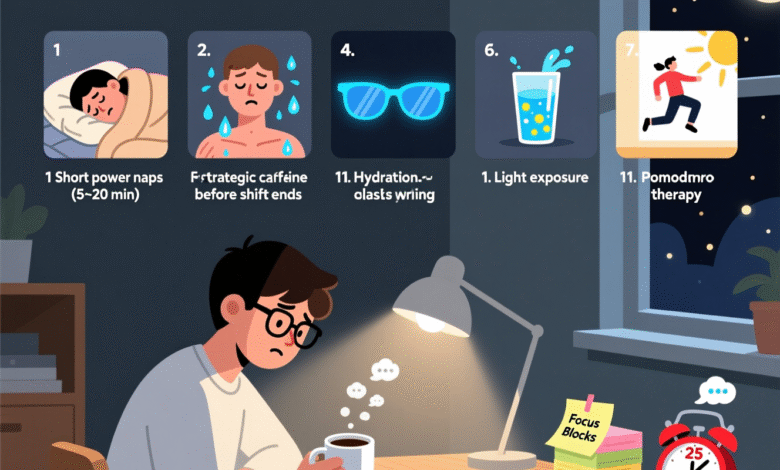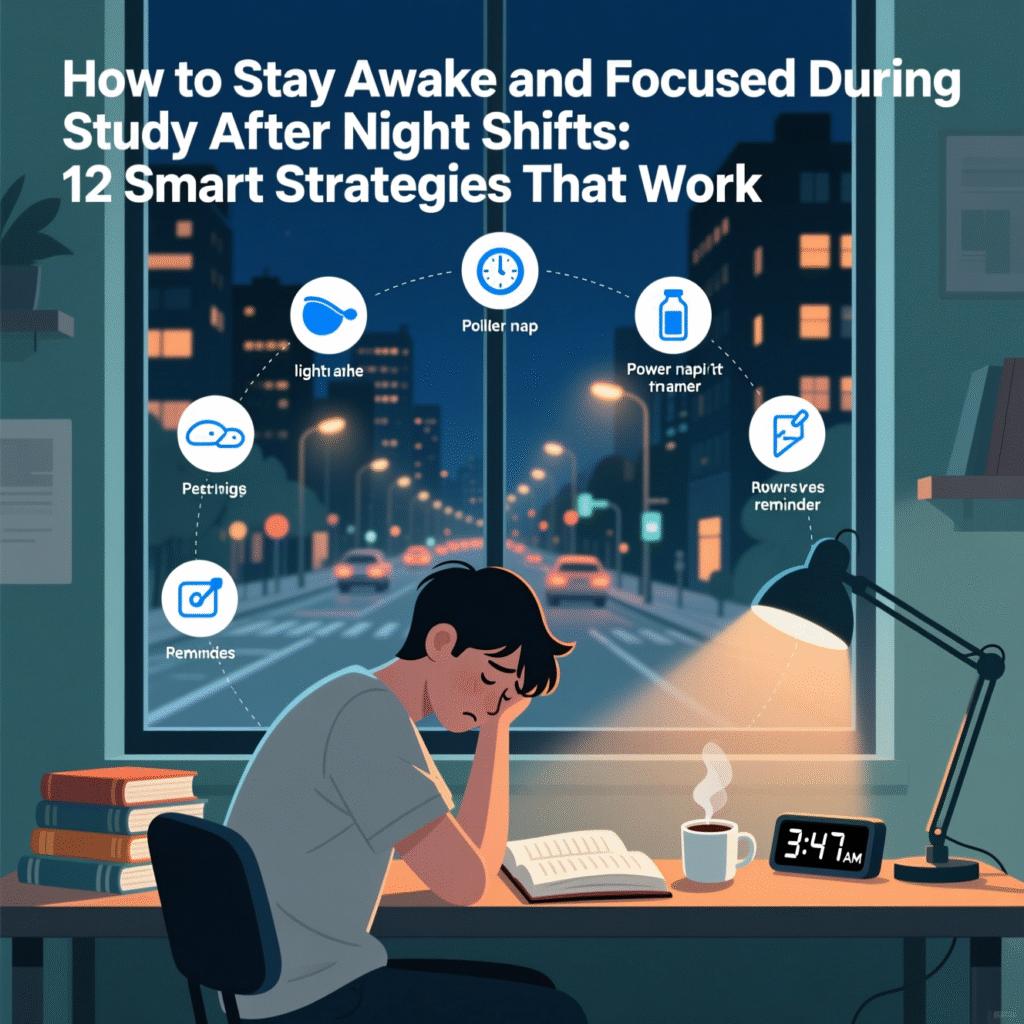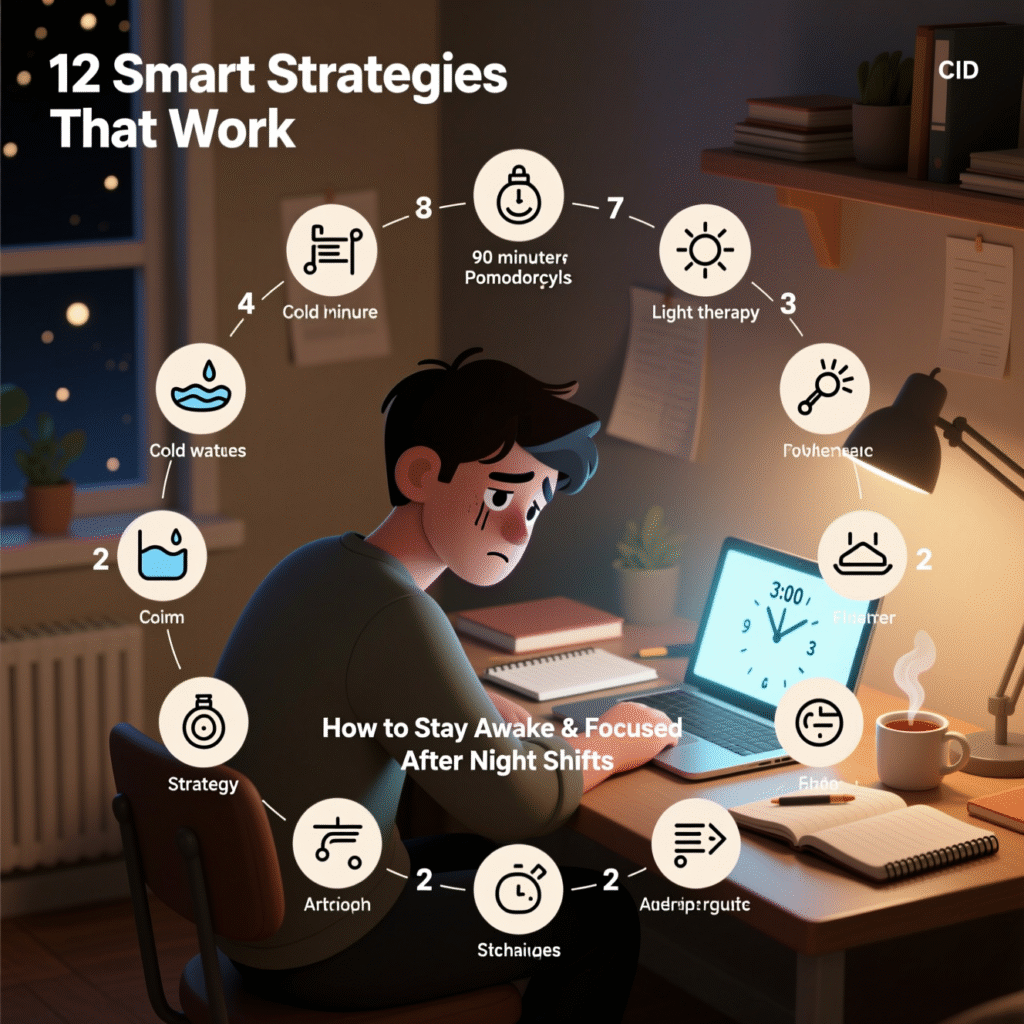how to stay awake and focused during study after night shifts: 12 smart strategies that work

how to stay awake and focused during study after night shifts ,You finish a long night on your feet, head humming and eyes gritty, yet your goals still need attention. You want grades that match your ambition, not a foggy cram session that slips away by morning. Here’s how you build alertness on demand, protect your sleep later, and get meaningful study done when the clock says rest.
Know your post-shift landscape
Night work pulls your body clock out of sync. Right after a shift, sleep inertia can make complex thinking feel slow. You can still study effectively—you just need a routine that adds light, movement, hydration, and smart timing to your toolkit.
- Target keywords to keep in mind: night shift study tips, stay awake while studying, focus after night shift, caffeine timing, bright light therapy, Pomodoro technique, low-GI snacks.
Your 12-point plan to stay sharp after nights

1) Time caffeine with intent
- Take 100–200 mg caffeine shortly before or at the start of your study block, not right before bed.
- Avoid caffeine within 6–8 hours of your main sleep window.
- Pair with L-theanine (100–200 mg) if coffee makes you jittery.
- Keywords: caffeine timing, stay awake while studying.
2) Use a power nap wisely
- Nap 10–20 minutes right after your shift or before you start studying.
- Set an alarm and sit up slightly to reduce grogginess.
- If you overshoot and feel heavy, splash cold water and move for two minutes.
3) Flip the light switch
- Give yourself bright light for 20–30 minutes at the start of study (sunlight or a 10,000 lux light box).
- After studying, dim lights and block blue light to protect sleep.
- Keywords: bright light therapy, focus after night shift.
4) Hydrate early, sip steadily
- Drink a full glass of water on clock-out.
- Keep a bottle nearby and sip every 10–15 minutes while you study.
- Add a pinch of salt and lemon if you sweat a lot during the shift.
5) Eat for steady energy, not a spike
- Aim for protein + fiber + healthy fats.
- Best picks: Greek yogurt with berries, eggs and whole-grain toast, tuna on rye, hummus with carrots.
- Avoid heavy, sugary meals that trigger a crash.
6) Move in micro-doses
- Every 25–30 minutes, stand up for 2–3 minutes: stairs, brisk marching, mobility drills.
- Movement boosts blood flow, lifts mood, and breaks monotony.
- Keywords: movement breaks, Pomodoro technique.
7) Build a focus-first study setup
- Bright room, cool air (18–20°C / 64–68°F), upright chair.
- Silence phone notifications; use website blockers.
- Keep only today’s materials on your desk to reduce cognitive clutter.
8) Study smart, not longer
- Use Pomodoro blocks: 25–30 minutes work, 3–5 minutes active break.
- Prioritize retrieval practice, spaced repetition, and interleaving over re-reading.
- Start with the single hardest task while alertness is highest.
9) Reset fast when energy dips
- Try a 60-second cold water face splash.
- Chew peppermint gum or sniff peppermint oil.
- Use 4-4-4-4 box breathing to steady focus.
10) Choose the right study window for you
- Option A: Study immediately post-shift with light + caffeine, then sleep.
- Option B: Short nap, light, snack, then study for 60–90 minutes.
- Track which option gives you better recall later that day.
11) Protect recovery sleep like a deadline
- Blackout curtains, cool room, white noise.
- Consistent sleep “anchors” across your week, even if total hours vary.
- If sleep debt builds, scale study time down before it breaks your streak.
12) Supplement carefully (optional)
- Caffeine + L-theanine for smoother focus.
- Magnesium glycinate at night if sleep quality suffers.
- Check medications and talk to your clinician if unsure.
A simple 90-minute study blueprint
- Minute 0–10: Hydrate, quick snack, bright light, caffeine dose.
- Minute 10–35: Block 1 (retrieval practice, hardest topic).
- Minute 35–38: Active break (stretch, stairs).
- Minute 38–63: Block 2 (practice problems, flashcards).
- Minute 63–66: Active break (water, peppermint).
- Minute 66–91: Block 3 (testing yourself, summarize key points).
- Minute 91–95: Plan tomorrow’s top 3 tasks, dim lights, begin wind-down.
Snack and sip ideas for steady focus
| Study fuel | Portion | Why it helps |
|---|---|---|
| Greek yogurt + blueberries + chia | 1 cup + 1/2 cup + 1 tbsp | Protein, fiber, low-GI carbs for steady energy |
| Apple + peanut butter | 1 medium + 1 tbsp | Slow-release carbs, healthy fat |
| Boiled eggs + rye crispbread | 2 eggs + 2 crisps | Protein keeps you fuller, reduces cravings |
| Trail mix (almonds, pumpkin seeds, dark chocolate) | 1/4 cup | Magnesium and flavanols for alertness |
| Electrolyte water with lemon | 16–20 oz | Hydration supports attention and mood |
Keywords to weave: study snacks for night shift, hydration for focus, low-GI study foods.
Common pitfalls and easy fixes
- Going straight from shift to bed then trying to study: add a short nap or light exposure first.
- Chasing energy with sugar: pick protein and fiber to avoid the slump.
- Studying in a warm, dim room: brighten and cool the space to cue alertness.
- Over-caffeinating: dose small and early; protect your sleep cycle.
- Re-reading notes: switch to retrieval practice and spaced repetition.
Safety first on your commute
- If you feel head nods or blurred vision, do not drive.
- Nap 15 minutes before commuting or choose safe transport.
- Your study can wait; safety and sleep come first.
Quick checklist you can screenshot
- Water, protein snack, bright light ready
- 100–200 mg caffeine (optional), timer set to 25–30 minutes
- Phone silenced, websites blocked
- Three priority tasks written down
- Active break plan: stairs, mobility, cold splash
- Post-study wind-down and sleep routine set

FAQs how to stay awake and focused during study after night shifts
What’s the fastest way to regain focus after a night shift?
Combine a 10–20 minute nap, bright light, and a small caffeine dose, then start with one hard task using the Pomodoro technique.
How long should you study after nights?
Aim for 60–120 minutes. Stop if you drift into microsleeps or accuracy drops—quality beats time-on-task.
Can you study effectively without caffeine?
Yes. Light exposure, micro-movement breaks, cold water resets, and low-GI snacks can lift alertness without coffee.
What is the best approach for how to stay awake and focused during study after night shifts?
Use a repeatable routine: nap or light, small caffeine, 2–4 Pomodoro blocks with retrieval practice, hydrate throughout, then protect sleep.
Are blue-light glasses and light boxes worth it?
Timed bright light can boost alertness; blue-light blockers help you wind down later. Use both strategically.
- Healthy Lifestyle for Night-Shift Students: 7 Keys to Long-Term Success
- How to Optimize Your Sleep Schedule as a Night-Shift Student in 2025
- Optimize Your Night-Shift Studies with This AI Planner
Conclusion: your focus is a system, not a guess
You don’t need superhuman willpower—you need a simple, repeatable system. When you pair light, movement, hydration, protein-rich snacks, and structured study blocks, you turn a tiring morning into a productive hour. The payoff is real: clearer recall, calmer study sessions, and sleep that actually restores you.
Ready to put this into action? Pick two strategies from the list and try them on your next shift cycle. Share what worked for you, drop your own night shift study tips in the comments, and pass this guide to a coworker who could use a boost. Your future self will thank you.
Primary keyword included naturally: how to stay awake and focused during study after night shifts. Secondary keywords sprinkled throughout: night shift study tips, stay awake while studying, focus after night shift, caffeine timing, bright light therapy, Pomodoro technique, spaced repetition, low-GI snacks, hydration for focus, recovery sleep.



